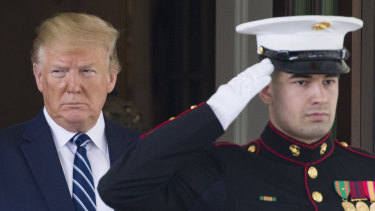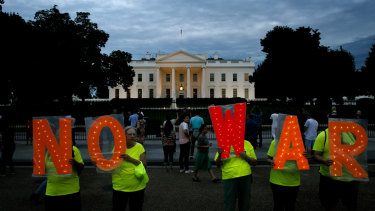Trump approved retaliatory strikes on Iran but pulled back at last minute: sources
Washington: US President Donald Trump approved military strikes against Iran in retaliation for downing an American surveillance drone but pulled back from launching them on Thursday night after a day of escalating tensions.
As late as 7pm on Thursday, Washington time, military and diplomatic officials were expecting a strike, after intense discussions and debate at the White House among the President's top national security officials and congressional leaders, according to multiple senior administration officials involved in or briefed on the deliberations.
President Donald Trump watches as Canadian Prime Minister Justin Trudeau departs the White House on Thursday.Credit:AP
Officials said the President had initially approved attacks on a handful of Iranian targets, like radar and missile batteries. But the action was abruptly called off for the evening.
It was not clear whether Trump simply changed his mind or whether the administration altered course because of logistics or strategy. It was also not clear whether the attacks might still go forward. The White House declined to comment, as did Pentagon officials.
The retaliation plan was intended as a response to the shooting down of the unmanned, $US130 million surveillance drone, which was struck Thursday morning by an Iranian surface-to-air missile, according to a senior administration official.
Protesters make their demands known outside the White House on Thursday.Credit:AP
The strike was set to take place just before dawn Friday in Iran to minimise risk to the Iranian military or to civilians. But military officials received word a short time later that the strike was off, at least temporarily.
Senior administration officials said Secretary of State Mike Pompeo, national security adviser John Bolton and CIA Director Gina Haspel had favoured a military response. But top Pentagon officials cautioned that such an action could result in a spiralling escalation with risks for US forces in the region.
Congressional leaders were briefed by administration officials in the Situation Room.
On Thursday, Trump insisted that the United States' unmanned surveillance aircraft was flying over international waters when it was taken down by an Iranian missile.
"This drone was in international waters, clearly," the president told reporters on Thursday afternoon.
Iran's government insisted that the drone had strayed into Iranian airspace, releasing GPS coordinates that put the drone 8 miles off the country's coast — inside the 12 nautical miles from the shore that Iran claims as its territorial waters.
Majid Takht-Ravanchi, Iran's ambassador to the United Nations, said Tehran "does not seek war" but "is determined to vigorously defend its land, sea and air."
The New York Times
Source: Read Full Article

